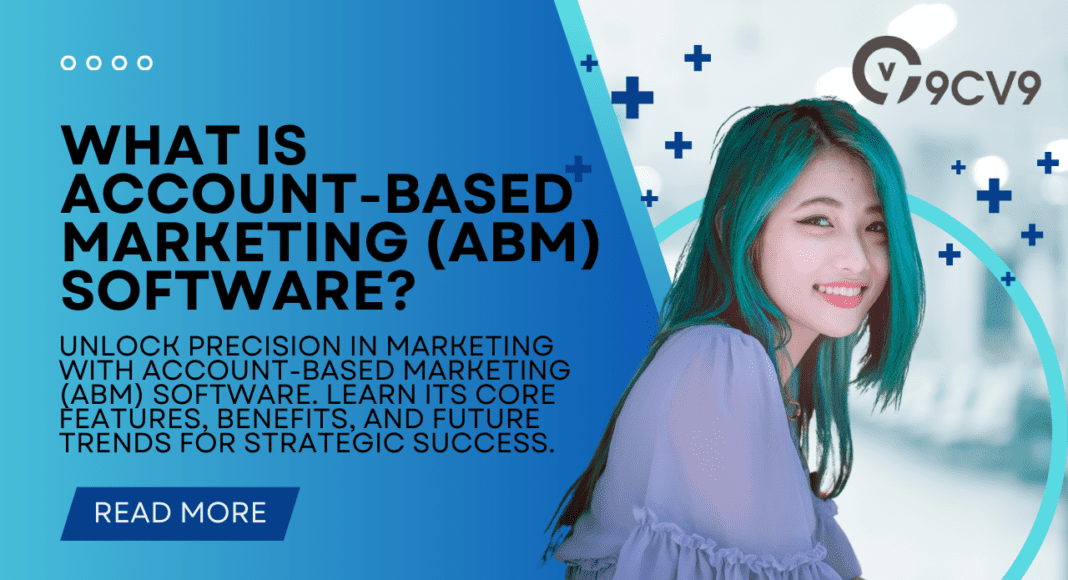Key Takeaways
- Precision Amplified: Uncover how Account-Based Marketing (ABM) Software elevates targeted marketing efforts, providing precision and efficiency through dynamic segmentation and personalized content creation.
- Strategic Implementation Insights: Explore key considerations for choosing, implementing, and optimizing ABM Software, with real-world examples illustrating successful strategies that align marketing and sales teams.
- Future-Forward Trends: Stay ahead in the marketing landscape by delving into the future trends of ABM Software, from AI integration to hyper-personalization, AR/VR applications, and the software’s evolving role in customer retention and global market expansion.
In the dynamic realm of modern marketing, staying ahead of the curve requires a strategic approach that transcends traditional methods.
Enter Account-Based Marketing (ABM) – a revolutionary strategy that has gained immense traction in recent years, reshaping how businesses engage with their most valuable prospects.
At the heart of this transformative methodology lies a powerful toolset: Account-Based Marketing Software.
As businesses navigate the digital landscape, the need for precision in targeting and personalized engagement has never been more critical.
ABM Software emerges as the linchpin in this evolution, offering marketers an arsenal of capabilities to hyper-focus their efforts on high-value accounts, fostering deeper connections and driving more impactful conversions.
Unveiling the Essence of Account-Based Marketing (ABM)
At its core, ABM represents a departure from the conventional, spray-and-pray marketing approach.
It embodies a strategic shift towards a more account-centric model, where marketing and sales efforts are finely tuned to resonate with the specific needs and preferences of key accounts.
ABM is not just a strategy; it’s a mindset that recognizes the importance of quality over quantity, targeting the right accounts with surgical precision.
Navigating the Marketing Landscape with ABM Software
However, the successful execution of ABM hinges on the sophisticated capabilities of Account-Based Marketing Software.
This powerful technology serves as the backbone, empowering marketing teams to navigate the intricacies of account-centric campaigns with finesse.
But what exactly is ABM Software, and how does it fit into the broader marketing ecosystem?
Decoding Account-Based Marketing Software
ABM Software, in essence, is a suite of tools designed to facilitate, streamline, and optimize the ABM process.
It serves as the digital brain behind targeted campaigns, equipping marketers with the means to identify, engage, and convert high-potential accounts more efficiently.
Picture it as the orchestrator of a symphony, harmonizing data-driven insights, personalization capabilities, and seamless integration with existing marketing and sales platforms.
The Strategic Advantages of ABM Software
The adoption of ABM Software isn’t just a technological upgrade; it’s a strategic imperative.
As marketing landscapes evolve and customer expectations soar, businesses leveraging ABM Software gain a competitive edge.
The benefits are multifaceted, ranging from heightened targeting precision and improved personalization to streamlined collaboration between marketing and sales teams.
This tool not only amplifies the effectiveness of ABM but also serves as a catalyst for organizational growth.
Exploring the Core Features of ABM Software
To comprehend the transformative power of ABM Software, it’s crucial to delve into its core features.
From advanced account selection algorithms and personalized content creation tools to seamless integration with Customer Relationship Management (CRM) systems, these features collectively empower marketers to craft and execute highly tailored campaigns.
ABM Software is not a one-size-fits-all solution; rather, it’s a versatile toolkit that adapts to the unique needs and goals of each business.
Peeling Back the Layers: How ABM Software Works
Understanding the mechanics behind ABM Software is key to unlocking its full potential.
This section will dissect the step-by-step process, shedding light on how data-driven decision-making, automation, and personalized content delivery converge to create a holistic ABM strategy.
Real-world examples will illustrate the transformative impact of ABM Software, showcasing its ability to turn prospects into long-term, high-value partnerships.
As we embark on this exploration of Account-Based Marketing (ABM) Software, we’ll unravel the intricacies, share expert insights, and equip you with the knowledge to make informed decisions for your business.
Whether you’re a seasoned marketer seeking to enhance your strategies or a business leader contemplating the adoption of ABM Software, this comprehensive guide will be your beacon in the evolving landscape of modern marketing.
Join us on this journey as we decode the power, potential, and practicalities of Account-Based Marketing Software.
Before we venture further into this article, we like to share who we are and what we do.
About 9cv9
9cv9 is a business tech startup based in Singapore and Asia with a strong presence all over the world.
With over seven years of startup and business experience, and being highly involved in connecting with thousands of companies and startups, the 9cv9 team has listed some important learning points in this overview of What is Account-Based Marketing (ABM) Software?
If your company needs recruitment and headhunting services to hire top employees, you can use 9cv9 headhunting and recruitment services to hire top talents and candidates. Find out more here, or send over an email to [email protected].
Or just post 1 free job posting here at 9cv9 Hiring Portal in under 10 minutes.
What is Account-Based Marketing (ABM) Software?
- Defining Account-Based Marketing (ABM)
- The Role of ABM Software
- Benefits of Using ABM Software
- Core Features of ABM Software
- How ABM Software Works
- Choosing the Right ABM Software
- Implementing ABM Software Successfully
- Future Trends in ABM Software
1. Defining Account-Based Marketing (ABM): The Essence of Account-Based Marketing (ABM)
In the fast-paced realm of modern marketing, the traditional spray-and-pray approach has given way to a more strategic paradigm: Account-Based Marketing (ABM).
At its core, ABM represents a fundamental shift from casting a wide net to a laser-focused strategy that tailors marketing efforts to specific high-value accounts.
Definition and Core Principles of ABM
- Definition: Account-Based Marketing is a targeted marketing strategy where businesses focus on identifying and engaging high-value accounts with personalized campaigns. It involves aligning marketing and sales efforts to resonate with the specific needs and preferences of key prospects.
- Core Principles:
- Precision Targeting: ABM zeros in on a select group of high-potential accounts rather than broadcasting to a broad audience.
- Personalization: Tailoring content and messaging to address the unique challenges and interests of each target account.
Example: Consider a B2B software company aiming to secure a contract with a Fortune 500 company. Instead of generic marketing, ABM would involve creating personalized content addressing the specific challenges and needs of that enterprise.

Differences Between Traditional Marketing and ABM
- Audience Focus:
- Traditional Marketing: Targets a broad audience based on demographics or industry.
- ABM: Concentrates efforts on a select number of high-value accounts.
- Campaign Approach:
- Traditional Marketing: Often uses mass media and generic messaging.
- ABM: Involves highly targeted, personalized campaigns tailored to each account.
Example: In traditional marketing, a consumer goods company may run a television ad to reach a wide audience. In ABM, a cybersecurity firm might create personalized content for a specific enterprise, addressing their cybersecurity concerns directly.

3. Targeting High-Value Accounts for Personalized Engagement
- Identifying Ideal Customer Profiles (ICPs):
- ABM starts by defining the characteristics of ideal customers to pinpoint high-value accounts.
- Personalized Engagement:
- Tailoring marketing efforts to resonate with the unique pain points and goals of each account.
Example: For a SaaS company offering project management software, the ICP might include large enterprises with distributed teams. ABM efforts would then involve creating content highlighting the software’s scalability and collaboration features tailored to each enterprise’s structure.
In essence, Account-Based Marketing is a strategic approach that recognizes the power of quality over quantity, focusing efforts where they matter most – on the accounts that hold the greatest potential for long-term, high-value partnerships.
In the following sections, we’ll explore the pivotal role of Account-Based Marketing Software in actualizing the principles of ABM.
2. Unveiling the Pivotal Role of ABM Software
As businesses embrace the transformative power of Account-Based Marketing (ABM), the linchpin to its successful execution lies in the sophisticated capabilities of Account-Based Marketing Software.
This section delves into the multifaceted role of ABM Software, showcasing how it empowers marketing teams to navigate the intricacies of account-centric campaigns with precision.
Overview of ABM Software
- Definition: ABM Software is a comprehensive suite of tools designed to facilitate, streamline, and optimize the entire ABM process.
- Centralized Hub: Serves as a centralized platform where marketers can orchestrate and monitor all ABM activities.
Facilitating Targeted and Personalized Campaigns
- Advanced Account Selection:
- Employs sophisticated algorithms to identify and prioritize high-potential accounts based on predefined criteria.
- Personalization Capabilities:
- Enables the creation and delivery of highly personalized content and messages tailored to the specific needs and pain points of each target account.
Example: Suppose a B2B company in the cybersecurity sector utilizes ABM Software. The software could analyze data to identify an enterprise with a recent data breach. The subsequent campaign would then deliver tailored content addressing the importance of robust cybersecurity measures.
Key Features Distinguishing ABM Software
- Data Integration:
- Seamlessly integrates with Customer Relationship Management (CRM) systems to leverage existing customer data.
- Automation:
- Automates repetitive tasks, such as email campaigns and social media interactions, freeing up time for more strategic initiatives.
Example: An e-commerce platform employing ABM Software integrates data from its CRM to identify high-value customers. Automation then triggers personalized email campaigns offering exclusive deals or tailored product recommendations.
Benefits of Using ABM Software for Businesses
- Heightened Targeting Precision:
- Enables marketers to identify and engage with accounts that align closely with ideal customer profiles, increasing the likelihood of conversion.
- Resource Optimization:
- Streamlines marketing efforts by focusing resources on accounts with the highest potential for revenue generation.
Example: A B2B tech company utilizing ABM Software experiences a significant increase in conversion rates by focusing marketing efforts on accounts matching their ideal customer profile, ultimately optimizing their marketing budget.
Integration with Existing Marketing and Sales Platforms
- Seamless Collaboration:
- Facilitates collaboration between marketing and sales teams by integrating with existing tools and platforms.
- Holistic View:
- Provides a holistic view of the customer journey by syncing data across various touchpoints.
Example: A company employing ABM Software seamlessly integrates it with its CRM and marketing automation platforms. This integration ensures that sales teams have real-time insights into the marketing activities of high-value accounts.
In essence, ABM Software acts as the engine driving the success of Account-Based Marketing strategies.
It not only amplifies the precision and personalization of campaigns but also empowers businesses to optimize resources and foster more meaningful connections with high-value accounts.
The next section will delve into the intricate workings of ABM Software, offering a detailed exploration of how it transforms targeted marketing into a strategic advantage.
3. Unlocking Strategic Advantages: Benefits of Using ABM Software
As businesses navigate the dynamic landscape of modern marketing, the adoption of Account-Based Marketing (ABM) Software emerges as a pivotal catalyst for success.
This section illuminates the diverse benefits that businesses can harness through the strategic implementation of ABM Software, offering a comprehensive exploration of its transformative impact.
Heightened Targeting Precision
- Focused Outreach:
- ABM Software empowers marketers to target a select group of high-potential accounts with precision.
- Ideal Customer Profile Alignment:
- Aligns marketing efforts with ideal customer profiles, ensuring that resources are invested where they are most likely to yield results.
Example: Consider a B2B software company aiming to secure contracts with large enterprises. ABM Software enables the identification and prioritization of accounts matching the company’s ideal customer profile, ensuring that marketing efforts are concentrated on prospects with the highest propensity for conversion.
Improved Personalization for Enhanced Engagement
- Tailored Content Creation:
- ABM Software facilitates the creation of highly personalized content and messaging tailored to the unique needs and challenges of each target account.
- Increased Relevance:
- Enhances engagement by delivering content that resonates with the specific pain points and interests of individual accounts.
Example: In the realm of healthcare technology, ABM Software enables the creation of personalized content addressing the unique challenges faced by different hospitals. For a hospital focused on patient experience, the software might deliver content emphasizing the user-friendly features of the technology.
Streamlined Marketing Efforts and Resource Allocation
- Resource Optimization:
- Allows businesses to allocate marketing resources more efficiently by focusing on high-value accounts.
- Cost Effectiveness:
- Reduces wastage of resources on broad campaigns that may not resonate with the target audience.

Example: A SaaS company utilizing ABM Software optimizes its marketing budget by concentrating efforts on accounts with the highest potential for subscription upgrades. This strategic allocation of resources leads to a more efficient use of the marketing budget.
Enhanced Collaboration Between Marketing and Sales Teams
- Unified Goals:
- Fosters alignment between marketing and sales teams by focusing on common objectives and shared insights.
- Real-Time Communication:
- Provides a platform for real-time communication and data sharing, ensuring that both teams are working with the latest information.
Example: A manufacturing company integrates ABM Software with its CRM system, enabling seamless communication between the marketing team identifying high-value accounts and the sales team engaging with those accounts. This integration ensures a unified approach towards converting targeted prospects.
Measurable ROI and Data-Driven Decision-Making
- Analytical Insights:
- ABM Software provides robust analytics and insights, allowing businesses to measure the success of campaigns and adjust strategies accordingly.
- Data-Driven Optimization:
- Enables data-driven decision-making, ensuring that marketing efforts are continually refined based on performance metrics.
Example: A financial services firm employs ABM Software to target high-net-worth individuals. Through analytics, the firm tracks the engagement levels of these individuals with targeted campaigns, allowing them to refine their approach and tailor future campaigns for greater impact.
Scalability Across Various Industry Verticals
- Versatility:
- ABM Software is adaptable to the unique needs of diverse industry verticals, making it a versatile tool for businesses across sectors.
- Industry-Specific Customization:
- Allows for customization of campaigns based on the specific nuances and requirements of different industries.
Example: An e-commerce platform successfully implements ABM Software to target both individual consumers and businesses. The software’s adaptability enables the creation of tailored campaigns, such as bulk discounts for B2B customers and personalized product recommendations for individual consumers.
In essence, the benefits of using ABM Software extend far beyond mere efficiency gains.
It becomes a strategic enabler, transforming targeted marketing into a nuanced and powerful approach that resonates with high-value accounts.
As we delve deeper into the nuances of ABM Software implementation, the next sections will explore best practices and real-world examples, shedding light on how businesses can harness its potential for sustained success.
4. Navigating Precision: Core Features of ABM Software
As businesses embark on the journey of Account-Based Marketing (ABM), the fulcrum of success lies in the capabilities of Account-Based Marketing Software.
This section navigates through the core features that define ABM Software, showcasing how these functionalities empower marketers to orchestrate targeted campaigns with finesse.
Account Selection and Prioritization Tools
- Algorithmic Precision:
- Utilizes advanced algorithms to analyze data and identify high-potential accounts based on predefined criteria.
- Scalability:
- Enables businesses to scale their ABM efforts by automating the selection process, ensuring efficiency even with a large pool of potential accounts.
Example: Imagine a technology company aiming to penetrate a new market. ABM Software, through its account selection tools, can analyze data points such as industry relevance, company size, and past engagement to pinpoint the most promising accounts for targeted campaigns.
Personalization and Customization Capabilities
- Dynamic Content Creation:
- Facilitates the creation of dynamic and personalized content that resonates with the unique needs of each target account.
- Behavioral Tracking:
- Incorporates behavioral tracking to adjust content in real-time based on the account’s engagement and interactions.
Example: In the realm of B2B software, ABM Software allows for the creation of personalized content addressing the specific pain points of each account. For a company in need of project management tools, the software dynamically adjusts content to highlight features tailored to their project complexity.
Integration with Customer Relationship Management (CRM) Systems
- Seamless Data Synchronization:
- Integrates seamlessly with CRM systems, ensuring that marketing teams have access to the latest customer data.
- 360-Degree View:
- Provides a comprehensive view of the customer journey by syncing data across platforms, enhancing the overall understanding of each account.
Example: A retail company employing ABM Software integrates it with their CRM system to understand the purchasing behavior of key accounts. This integration ensures that marketing campaigns align with the customer’s preferences and historical interactions.

Automation for Efficiency and Consistency
- Campaign Automation:
- Automates repetitive tasks such as email campaigns, social media interactions, and lead scoring, freeing up time for strategic planning.
- Consistent Engagement:
- Ensures consistent engagement by automating follow-ups and responses based on predefined triggers.
Example: Consider a financial services firm utilizing ABM Software to target businesses. Automation streamlines the sending of personalized financial reports to each account, ensuring a consistent and timely engagement that aligns with their financial needs.
Analytics and Reporting Tools
- Performance Metrics:
- Provides robust analytics and reporting tools to measure the success of ABM campaigns.
- Data-Driven Insights:
- Empowers marketers with data-driven insights, facilitating informed decision-making and continuous optimization.
Example: A software-as-a-service (SaaS) company employs ABM Software and uses analytics to track engagement metrics for targeted accounts. The insights gathered inform the marketing team, enabling them to refine their approach and tailor future campaigns for greater impact.
Dynamic Segmentation and Targeting
- Granular Segmentation:
- Enables marketers to dynamically segment and target accounts based on changing criteria.
- Real-Time Adjustments:
- Allows for real-time adjustments to targeting parameters, ensuring campaigns remain relevant and adaptive.
Example: An e-commerce platform employing ABM Software dynamically adjusts its targeting criteria based on the purchasing behavior of key accounts. If a business customer suddenly shows interest in a new product category, the software adapts the targeting to align with this evolving interest.
In essence, the core features of ABM Software weave together a tapestry of capabilities, enabling businesses to navigate the complexities of account-centric campaigns with precision and efficiency.
As we traverse through the next sections, we’ll explore how these features come to life through real-world examples and best practices, offering insights into the strategic implementation of ABM Software for sustained success.
5. Decoding the Mechanics: How ABM Software Works
As businesses embrace the strategic shift towards Account-Based Marketing (ABM), the intricate workings of ABM Software take center stage.
This section navigates through the nuances of how ABM Software operates, unraveling the data-driven decision-making, automation, and personalized engagement that define its essence.
Data-Driven Decision-Making in ABM Software
- Comprehensive Data Analysis:
- ABM Software begins by analyzing vast datasets to identify and prioritize high-value accounts.
- Ideal Customer Profile (ICP):
- Utilizes predefined criteria to create an Ideal Customer Profile, aligning marketing efforts with the characteristics of the most valuable accounts.

Example: Consider a B2B technology company employing ABM Software. The software analyzes data points such as company size, industry relevance, and past engagement to identify accounts that closely match the ideal customer profile – those with the highest likelihood of conversion.
Integration with Customer Relationship Management (CRM) Systems
- Unified Data Ecosystem:
- ABM Software seamlessly integrates with CRM systems, ensuring that marketing teams have access to the latest customer data.
- Customer Journey Visibility:
- Provides a 360-degree view of the customer journey by syncing data across platforms, allowing for a holistic understanding of each account.
Example: An e-commerce platform integrates ABM Software with its CRM system. This integration ensures that marketing campaigns align with the historical interactions and preferences of each account, fostering a personalized and cohesive customer journey.
Automation and Personalization in ABM Software
- Automated Campaign Execution:
- ABM Software automates the execution of targeted campaigns, streamlining repetitive tasks such as email outreach and social media interactions.
- Dynamic Personalization:
- Enables dynamic personalization of content and messaging based on real-time data and account behavior.
Example: In the healthcare industry, a company utilizes ABM Software to automate the delivery of personalized content to hospitals in its target accounts. If a hospital shows increased interest in a specific medical solution, the software dynamically adjusts subsequent content to emphasize relevant features.
Examples of Successful ABM Software Implementation
- Case Study Showcases:
- Examining real-world examples of businesses that have successfully implemented ABM Software, showcasing measurable results and ROI.
- Industry-Specific Success Stories:
- Highlighting success stories across various industry verticals, demonstrating the adaptability and effectiveness of ABM Software.
Example: A software development company shares a case study illustrating the success of ABM Software in securing high-value contracts. By targeting specific enterprises with tailored campaigns, the company achieved a significant increase in conversion rates and revenue, showcasing the tangible impact of ABM Software.
Step-by-Step Breakdown of the ABM Software Process
- Account Selection:
- ABM Software begins by selecting high-value accounts through data analysis and alignment with the Ideal Customer Profile.
- Personalized Content Creation:
- Once accounts are identified, the software facilitates the creation of personalized content tailored to the unique needs of each account.
- Campaign Execution:
- Automated campaign execution ensures that the personalized content is delivered through various channels, maximizing reach and engagement.
- Analytics and Optimization:
- ABM Software continuously analyzes campaign performance, providing data-driven insights that inform ongoing optimization strategies.

Example: A cybersecurity firm employing ABM Software follows this step-by-step process. The software identifies accounts with a high risk of security breaches, personalizes content addressing specific vulnerabilities, automates the delivery of this content through email campaigns, and utilizes analytics to refine strategies based on engagement data.
In essence, the workings of ABM Software embody a synergy of data-driven precision, seamless integration, and dynamic personalization.
As we venture into the next sections, we’ll explore best practices for successful ABM Software implementation and delve into challenges and solutions, providing a holistic understanding of how businesses can harness the full potential of this transformative technology.
6. Navigating Choices: Choosing the Right ABM Software
As businesses embark on the journey of embracing Account-Based Marketing (ABM), selecting the right ABM Software becomes a critical decision.
This section delves into the nuanced considerations and key factors that businesses should evaluate when choosing ABM Software, providing insights and guidance for a strategic decision-making process.
Factors to Consider When Selecting ABM Software
- Business Goals Alignment:
- Ensure that the chosen ABM Software aligns with the overarching goals and objectives of the business.
- Scalability:
- Evaluate the scalability of the software to accommodate the growth of ABM efforts as the business expands.
- Integration Capabilities:
- Assess the software’s ability to seamlessly integrate with existing marketing and sales platforms, especially with Customer Relationship Management (CRM) systems.
Example: A B2B manufacturing company with ambitious growth goals chooses ABM Software that aligns with its focus on targeting high-value accounts in specific regions. The software’s scalability ensures that it can accommodate the expansion into new markets.
Comparison of Popular ABM Software Tools in the Market
- Vendor Research:
- Conduct thorough research on different ABM Software vendors, comparing their features, pricing structures, and customer reviews.
- User-Friendly Interface:
- Assess the user-friendliness of the software interface to ensure that both marketing and sales teams can navigate and utilize the platform effectively.
- Customization Options:
- Evaluate the degree of customization offered by each software tool, considering the unique needs and preferences of the business.
Example: A technology company exploring ABM Software options compares multiple vendors, focusing on user reviews highlighting ease of use. The chosen software stands out for its intuitive interface and customizable features.
Tips for Evaluating and Making an Informed Decision
- Trial Periods and Demos:
- Leverage trial periods and software demos to gain hands-on experience and assess how well the software aligns with the business requirements.
- Scalability Provisions:
- Engage in discussions with vendors to understand the scalability provisions of the software and how it can adapt to evolving business needs.
- Customer Support and Training:
- Prioritize software providers that offer robust customer support and training programs to ensure a smooth onboarding process.
Example: A healthcare organization exploring ABM Software options requests trial periods from shortlisted vendors. The chosen software not only aligns with their needs during the trial but also offers comprehensive training resources for their marketing and sales teams.
Best Practices for Successful ABM Software Implementation
- Alignment with Sales Teams:
- Foster collaboration and alignment between marketing and sales teams to ensure the software meets the needs of both departments.
- Continuous Monitoring and Adaptation:
- Implement a strategy for continuous monitoring and adaptation of ABM strategies based on the insights provided by the software.
- Data Security Measures:
- Prioritize ABM Software providers with robust data security measures to protect sensitive customer information.
Example: A financial services firm ensures successful ABM Software implementation by establishing regular communication channels between marketing and sales teams. The software’s insights guide ongoing adjustments to the ABM strategy for optimal performance.
Addressing Challenges in ABM Software Adoption
- Change Management Strategies:
- Develop change management strategies to address potential resistance or challenges in adopting new ABM Software.
- Training Initiatives:
- Invest in comprehensive training initiatives to ensure that team members are proficient in using the software’s features.
- Performance Metrics Alignment:
- Align the software’s performance metrics with key performance indicators (KPIs) to measure its impact on overall business goals.
Example: A retail company encounters initial resistance to ABM Software adoption among its sales team. Change management strategies, including tailored training programs and clear communication about the software’s benefits, help overcome resistance and foster a collaborative approach.
In essence, choosing the right ABM Software involves a meticulous evaluation of business needs, vendor capabilities, and the potential for seamless integration.
By aligning software features with strategic goals, businesses can pave the way for successful ABM implementation, driving targeted engagement and fostering long-term relationships with high-value accounts.
As we delve into real-world case studies and explore emerging trends in ABM Software, the next sections will provide a holistic understanding of how businesses can harness this transformative tool for sustained success.
7. Orchestrating Success: Implementing ABM Software Successfully
As businesses venture into the realm of Account-Based Marketing (ABM), the successful implementation of ABM Software emerges as a critical factor in realizing the full potential of this transformative strategy.
This section navigates through the intricacies of implementing ABM Software successfully, offering insights, best practices, and real-world examples.
Aligning Marketing and Sales Teams for Seamless Execution
- Collaborative Workshops:
- Organize collaborative workshops and training sessions to align marketing and sales teams on the objectives, strategies, and functionalities of the ABM Software.
- Establishing Common Goals:
- Ensure that both teams share common goals and KPIs, fostering a unified approach towards engaging high-value accounts.
- Example: A technology company introduces ABM Software and conducts joint workshops for marketing and sales teams. The teams collaboratively define target account criteria and establish shared goals, fostering a seamless execution of ABM strategies.
Creating Personalized Content and Campaigns
- Utilizing Software Features:
- Leverage the personalization and customization features of ABM Software to create tailored content and campaigns for each high-value account.
- Dynamic Content Delivery:
- Implement dynamic content delivery based on real-time data and behavioral tracking, ensuring that messaging remains relevant.
- Example: In the hospitality sector, a hotel chain implements ABM Software to target corporate clients. The software’s personalization features enable the creation of tailored campaigns offering exclusive business travel packages, resulting in increased engagement.
Leveraging Analytics and Insights for Optimization
- Regular Performance Analysis:
- Regularly analyze the performance metrics provided by ABM Software to assess the effectiveness of campaigns and strategies.
- Continuous Optimization Strategies:
- Develop strategies for continuous optimization based on insights, adapting campaigns to align with evolving account behavior.
- Example: A financial services firm employs ABM Software and regularly analyzes engagement metrics. Insights reveal a shift in the preferences of targeted accounts, prompting the optimization of future campaigns to better align with changing needs.
Integrating ABM Software into Existing Workflows
- Seamless Integration Planning:
- Plan the seamless integration of ABM Software into existing marketing and sales workflows, avoiding disruptions.
- CRM Integration Strategies:
- Integrate ABM Software with Customer Relationship Management (CRM) systems to ensure a cohesive view of customer interactions.
- Example: A retail company integrates ABM Software with its CRM system to align customer data. The integration ensures that the marketing team has real-time insights into customer interactions, enabling more targeted campaigns.
Collaborating with Sales Teams for Strategic Engagement
- Regular Communication Channels:
- Establish regular communication channels between marketing and sales teams to exchange insights, feedback, and updates.
- Joint Strategy Sessions:
- Conduct joint strategy sessions to align sales outreach with marketing campaigns, maximizing the impact on targeted accounts.
- Example: A manufacturing company utilizes ABM Software, fostering regular communication between marketing and sales teams. Joint strategy sessions enable the sales team to tailor their outreach based on the insights gained from marketing campaigns, leading to more effective engagement.
Measuring and Communicating ROI from ABM Software
- Defining Key Metrics:
- Clearly define key performance indicators (KPIs) and metrics to measure the Return on Investment (ROI) from ABM Software.
- Regular Reporting:
- Implement regular reporting mechanisms to communicate the tangible impact of ABM Software to key stakeholders.
- Example: A software development company employing ABM Software establishes key metrics, including conversion rates and revenue generated from targeted accounts. Regular reports demonstrate the software’s contribution to the company’s overall growth.
Implementing Data-Driven Decision-Making Processes
In essence, the successful implementation of ABM Software goes beyond technical integration; it involves fostering a collaborative and data-driven culture within the organization.
As we venture into real-world case studies and explore emerging trends, the subsequent sections will provide a comprehensive understanding of how businesses can navigate challenges and leverage ABM Software for sustained success.
8. Navigating Tomorrow: Future Trends in ABM Software
As the marketing landscape continues to evolve, the trajectory of Account-Based Marketing (ABM) Software is set to undergo transformative changes.
This section explores the anticipated future trends in ABM Software, shedding light on the innovations and strategies that businesses can harness for sustained success.
AI and Machine Learning Integration
- Dynamic Account Scoring:
- AI and machine learning algorithms will evolve to provide more dynamic and accurate account scoring, allowing marketers to prioritize high-potential accounts with greater precision.
- Predictive Analytics for Personalization:
- Advanced predictive analytics will enhance personalization by anticipating account behaviors and preferences, enabling the creation of more targeted content.
- Example: An e-commerce platform implementing AI-integrated ABM Software utilizes predictive analytics to forecast the product preferences of high-value accounts. This enables the creation of personalized campaigns offering relevant products before the account even expresses the need.
Hyper-Personalization Strategies
- Individual Stakeholder Targeting:
- ABM Software will evolve to enable hyper-personalization at an individual stakeholder level within target accounts, tailoring content and messaging to specific decision-makers.
- Behavioral Trigger Campaigns:
- Automated campaigns triggered by real-time behavioral data will become more sophisticated, ensuring that the right content is delivered at the right moment.
- Example: In the B2B tech sector, hyper-personalization involves crafting campaigns not just for the target company but for individual stakeholders. ABM Software detects the engagement of a CTO with specific content, prompting automated campaigns addressing their unique concerns.
Cross-Channel Integration for Seamless Campaigns
- Unified Cross-Channel Strategies:
- Future ABM Software will seamlessly integrate across various marketing channels, ensuring a unified and consistent experience for target accounts.
- Integrated Social Media Campaigns:
- ABM campaigns will extend seamlessly to social media platforms, with software facilitating integrated strategies for cohesive engagement.
- Example: A healthcare company leverages ABM Software that integrates seamlessly with social media platforms. Targeted accounts not only receive personalized emails but also encounter tailored content on their social media feeds, creating a unified brand experience.
ABM Software for Customer Retention
- Shift from Acquisition to Retention:
- ABM Software will increasingly be utilized for customer retention strategies, allowing businesses to nurture existing high-value accounts.
- Automated Loyalty Programs:
- Automated campaigns will focus on enhancing customer loyalty, offering personalized incentives and exclusive deals to retained accounts.
- Example: A subscription-based service employs ABM Software to retain existing customers. Automated campaigns offer personalized discounts and exclusive content based on the customer’s usage patterns, fostering long-term loyalty.
Enhanced Data Security and Compliance Measures
- Stricter Data Governance:
- Future ABM Software iterations will incorporate stricter data governance measures to ensure compliance with evolving data protection regulations.
- Blockchain Integration for Security:
- Some ABM Software solutions may explore blockchain technology for secure and transparent data handling, providing an added layer of trust.
- Example: A finance company adopts ABM Software with enhanced data security measures. The software utilizes blockchain for transactional data, ensuring that customer information is not only protected but also auditable for compliance purposes.
Augmented Reality (AR) and Virtual Reality (VR) in ABM
- Immersive Content Experiences:
- ABM Software will leverage AR and VR technologies to create immersive content experiences, allowing businesses to showcase products or services in a virtual environment.
- Virtual Product Demonstrations:
- Virtual product demonstrations and simulations will become a part of ABM campaigns, enhancing engagement and understanding.
- Example: In the real estate sector, ABM Software integrates AR to offer virtual property tours for high-value accounts. This immersive experience allows potential clients to explore properties remotely, enhancing their engagement and interest.
Global Expansion of ABM Strategies
- Localization for Diverse Markets:
- ABM Software will evolve to cater to diverse global markets, offering localization features that adapt campaigns to regional nuances.
- Cultural Sensitivity in Content:
- Future ABM campaigns will prioritize cultural sensitivity, with software facilitating the creation of content that resonates with diverse audiences.
- Example: A tech company expanding into international markets employs ABM Software with localization capabilities. The software tailors campaigns not just based on language but also considers cultural preferences, ensuring relevance across regions.
Advanced Attribution Models for ROI Measurement
- Multi-Touch Attribution Models:
- ABM Software will adopt more advanced attribution models, providing marketers with a clearer understanding of the impact of each touchpoint in the customer journey.
- AI-Driven Attribution Insights:
- AI-driven insights will enhance attribution models, helping businesses attribute conversions to specific ABM strategies with greater accuracy.
- Example: A software company employs ABM Software with advanced attribution models. AI-driven insights reveal that a combination of personalized email campaigns and social media interactions significantly contributes to conversions, allowing for more targeted future strategies.
In the rapidly evolving landscape of ABM Software, these future trends showcase a trajectory towards greater personalization, integration, and strategic alignment with business goals.
As businesses embrace these advancements, the next sections will delve into case studies and best practices, providing actionable insights for navigating the future of ABM Software successfully.
Conclusion
In the dynamic realm of modern marketing, where precision, personalization, and strategic engagement reign supreme, Account-Based Marketing (ABM) Software emerges as the catalyst that propels businesses towards targeted success.
As we traverse the depths of this comprehensive exploration into “What is Account-Based Marketing (ABM) Software?” it becomes abundantly clear that ABM Software is not merely a tool; it is a strategic enabler, transforming how businesses identify, engage, and nurture high-value accounts.
A Recap of the ABM Software Landscape
We embarked on a journey to demystify the intricate workings of ABM Software, unveiling its core features, benefits, and the pivotal role it plays in orchestrating successful Account-Based Marketing campaigns.
From personalized content creation and dynamic segmentation to seamless integration with Customer Relationship Management (CRM) systems, ABM Software emerged as the linchpin that amplifies the precision, efficiency, and impact of targeted marketing efforts.
Strategic Implementation: Choosing, Implementing, and Optimizing ABM Software
Choosing the right ABM Software proved to be a strategic decision, necessitating alignment with business goals, scalability considerations, and seamless integration into existing workflows.
Examples illustrated how businesses, spanning various industries, successfully implemented ABM Software, fostering collaboration between marketing and sales teams, leveraging analytics for optimization, and measuring tangible ROI.
The Evolving Landscape: Future Trends in ABM Software
Looking forward, we explored the future trends shaping the landscape of ABM Software.
From the integration of Artificial Intelligence (AI) and Machine Learning for dynamic account scoring to the rise of hyper-personalization strategies and the integration of Augmented Reality (AR) and Virtual Reality (VR), the future promises a landscape where ABM Software becomes even more sophisticated and integral to marketing strategies.
Navigating Challenges and Embracing Opportunities
While the potential of ABM Software is vast, challenges such as data security concerns and the need for cultural sensitivity in global campaigns underscore the importance of strategic implementation and ongoing adaptation.
The evolving nature of ABM Software invites businesses to not only embrace innovation but also to navigate challenges with a proactive mindset, ensuring sustained success in an ever-changing marketing environment.
The Road Ahead: Harnessing the Full Potential of ABM Software
As businesses stand at the crossroads of the marketing landscape, ABM Software beckons as a beacon of strategic advantage.
Its transformative power lies not only in the capabilities it offers today but also in its ability to evolve and adapt to the ever-shifting sands of the marketing terrain.
The road ahead involves not merely adopting ABM Software but harnessing its full potential through continuous learning, strategic alignment, and a commitment to customer-centricity.
In conclusion, Account-Based Marketing (ABM) Software is not just a technological tool; it is a strategic imperative for businesses aiming to elevate their marketing efforts to new heights.
Whether navigating the intricacies of B2B relationships, fostering customer loyalty, or expanding into global markets, ABM Software stands as a versatile ally, empowering businesses to forge meaningful connections, drive targeted engagements, and navigate the future of marketing with unparalleled precision.
As we bid adieu to this exploration, the call to action is clear: embrace the power of ABM Software, navigate the future with confidence, and redefine the trajectory of marketing success.
If your company needs HR, hiring, or corporate services, you can use 9cv9 hiring and recruitment services. Book a consultation slot here, or send over an email to [email protected].
If you find this article useful, why not share it with your hiring manager and C-level suite friends and also leave a nice comment below?
We, at the 9cv9 Research Team, strive to bring the latest and most meaningful data, guides, and statistics to your doorstep.
To get access to top-quality guides, click over to 9cv9 Blog.
People Also Ask
What is the full form of ABM in marketing?
The full form of ABM in marketing is Account-Based Marketing. It is a strategic approach where marketing efforts focus on a targeted set of high-value accounts, tailoring campaigns and content to address the specific needs and interests of individual accounts, fostering personalized and effective engagement.
What are the three types of account-based marketing?
The three types of Account-Based Marketing (ABM) are:
- Strategic ABM (One-to-One): Tailored for individual high-value accounts.
- ABM Lite (One-to-Few): Targets a cluster of accounts with shared characteristics.
- Programmatic ABM (One-to-Many): Scales efforts to reach a broader audience while maintaining personalization.
What are the objectives of account-based marketing?
The objectives of Account-Based Marketing (ABM) include targeting high-value accounts, personalizing marketing efforts, aligning sales and marketing strategies, fostering customer relationships, and maximizing ROI through tailored campaigns that address the unique needs and pain points of specific accounts.































![Writing A Good CV [6 Tips To Improve Your CV] 6 Tips To Improve Your CV](https://blog.9cv9.com/wp-content/uploads/2020/06/2020-06-02-2-100x70.png)


